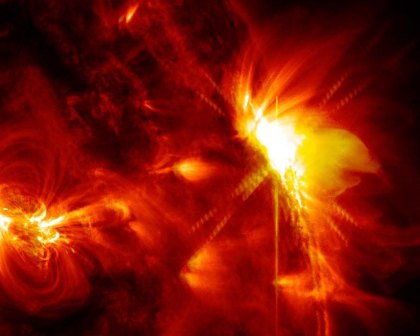Today's Post:
Solar storm in 1967 could have resulted in war

A solar storm was thought to be an attack in 1967.
Image: NASA
“One of the largest geomagnetic storms on record began on 25 May,” recounts a research paper on the event, The May 1967 Great Storm and Radio Disruption Event: Extreme Space Weather and Extraordinary Responses. The study was led by Delores Knipp, a research professor in aerospace engineering sciences at the University of Colorado, Boulder. Retired Air Force officers were involved in the research, which has been accepted for publication in Space Weather, a journal of the American Geophysical Union.
The solar flares took place at a time when both the U.S. and Soviet Union had acquired nuclear weapons “as part of the doctrine of mutually assured destruction,” the paper notes. The U.S. military was also involved in the Vietnam War and tensions were flaring in the Middle East.
The U.S. Strategic Air Command (SAC) developed exercises in which bomber aircraft were prepared to quickly launch. At the same time, the North American Air Defense Command (NORAD) operated the Ballistic Missile Early Warning System “designed to track space objects and detect incoming intercontinental missiles,” according to the paper.
On May 23, all three early warning sites in the far Northern Hemisphere were disrupted. “Such an intense, never-before-observed solar radio burst was interpreted as jamming,” the authors wrote. “Cold War military commanders viewed full scale jamming of surveillance sensors as a potential act of war.”
An Air Force colonel and his NORAD solar forecasting staff were credited with providing information that eventually calmed nerves and allowed aircraft engines to cool, according to the research.
“It is well worth noting that during the politically tense days of late May 1967, a full out aircraft launch by Western forces could have been very provocative, and just as importantly, difficult (if not impossible) to recall in the greatly challenged HF-UHF radio environment," the research paper notes. "SAC crews were trained to ‘complete the mission’ unless clearly recalled.”
The paper has been published on the Wiley Online Library website.
Related:
NASA observatory captures image of solar flare
If you would like to comment, give us a shout, or like us on Facebook and tell us what you think.

